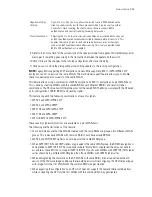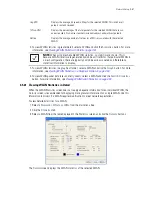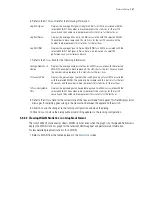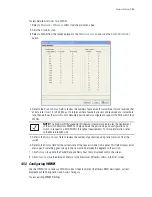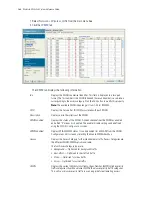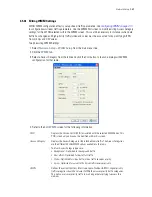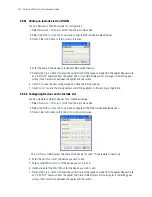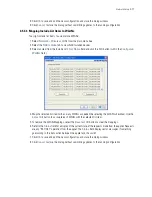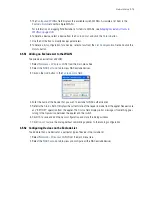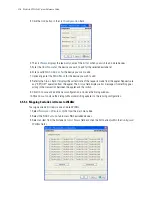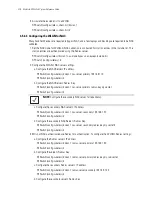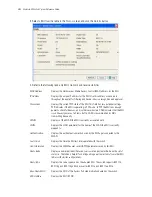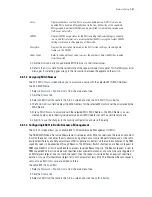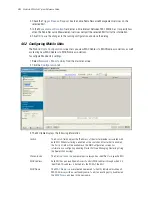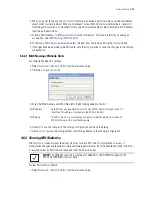
4-70
Motorola RF Switch System Reference Guide
5. Refer to the
Status
field for the current state of the requests made from applet. This field displays error
messages if something goes wrong in the transaction between the applet and the switch.
6. Click
OK
to use the changes to the running configuration and close the dialog.
7. Click
Cancel
to close the dialog without committing updates to the running configuration.
4.5.4 Configuring the NAC Inclusion List
Using NAC, the switch acts as an enforcement entity before allowing MU access to specific network
resources. NAC performs a MU host integrity check wherein an MU sends host integrity information to the
NAC server. The NAC server configuration is defined on the switch on a per WLAN basis. NAC verifies an
MU’s compliance with the NAC server’s security policy (not the switch).
For a NAC configuration example using the switch CLI, see
NAC Configuration Examples Using the Switch
CLI on page 4-77
.
An include list is a list of MAC addresses configured for a WLAN. During EAP authentication, the EAP server
(Radius or NAC server) is determined based on the MU’s MAC address.
• All non-802.1x devices are partitioned into a WLAN (separate from a 802.1x enabled WLAN).
• Communication between devices in a 802.1x supported WLAN and a non 802.1x supported WLAN is
achieved by merging the WLANs within the same VLAN.
The switch uses the include list to add devices that are NAC supported. The following explains how
authentication is achieved using 802.1x. The switch authenticates 802.1x enabled devices using one of the
following:
•
NAC Agent
– NAC support is added in the switch to allow the switch to communicate with a LAN
enforcer (a laptop with a NAC agent installed).
•
No NAC Agent
– NAC support is achieved using an exclude list. For more information, see
Configuring the NAC Exclusion List on page 4-74
.
By default, a WLAN is NAC disabled. Each WLAN can be configured to:
• Conduct a NAC check for MU's connecting to the WLAN as well as perform an additional exclude
function, by attaching an exclude list to the WLAN.
• Do not perform NAC validation for MUs connecting to the WLAN.
• Include a few MUs for NAC validation and bypass the rest of the MUs.
Transmit Ops
Defines the maximum duration a device can transmit after obtaining a transmit
opportunity. For higher-priority traffic categories, this value should be set to a low
number.
CW Minimum
The CW Minimum is combined with the CW Maximum to make the Contention
screen. From this range, a random number is selected for the back off mechanism.
Select a lower value for high priority traffic.
CW Maximum
The CW Maximum is combined with the CW Minimum to make the Contention
screen. From this range, a random number is selected for the back off mechanism.
Lower values are used for higher priority traffic
Max Retries
Defines a maximum number of retries for each Access Category.
Use DSCP or 802.1p
Selects the DSCP or 802.1p radio buttons to choose between DSCP and 802.1p.
Summary of Contents for RFS Series
Page 1: ...M Motorola RFS Series Wireless LAN Switches WiNG System Reference Guide ...
Page 10: ...TOC 8 Motorola RF Switch System Reference Guide ...
Page 56: ...2 8 Motorola RF Switch System Reference ...
Page 334: ...5 52 Motorola RF Switch System Reference 2 Select the MU Status tab ...
Page 510: ...7 32 Motorola RF Switch System Reference Guide ...
Page 534: ...8 24 Motorola RF Switch System Reference Guide ...
Page 570: ...C 14 Motorola RF Switch System Reference Guide ...
Page 589: ......




